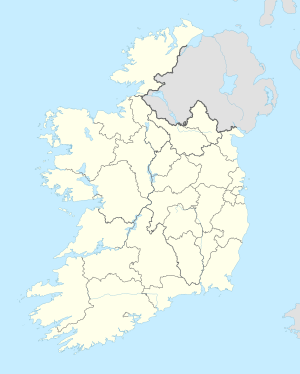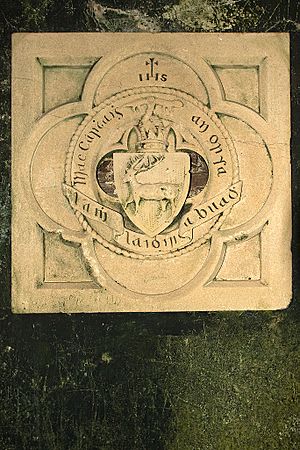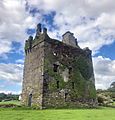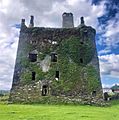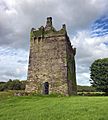Togher Castle facts for kids
Quick facts for kids Togher Castle |
|
|---|---|
| County Cork, Ireland | |
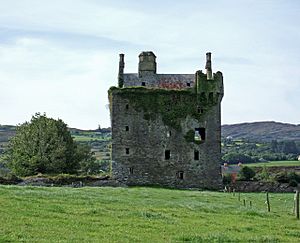
Togher Castle – south facade
|
|
| Coordinates | 51°45′43″N 9°09′54″W / 51.761869°N 09.164867°W |
| Type | Fortified tower house |
| Height | 18 metres (approximately) |
| Site information | |
| Controlled by | MacCarthy family of Gleannacroim Captain Edward Hoare and Lieutenant Abraham Hoare The Barry family The O'Donovan family |
| Condition | Partial ruin |
| Site history | |
| Built | c. 1590 |
Togher Castle (in Irish: Caisleán an Tóchar) is an old stone building from the late 1500s. It's a type of strong house called a tower house. People mostly know it because of its connection to the MacCarthy family, who lived in a place called Gleannacroim. The castle is about 9 kilometers (5.6 miles) north of Dunmanway town in County Cork, Ireland. The name "Togher" comes from an Irish word meaning "causeway" or a "wooden path over a bog".
Contents
What Togher Castle Looks Like
Togher Castle stands on a low, rocky hill, about 100 meters (328 feet) north of the River Bandon. People think it was built where an even older building once stood. Even though it's been changed a little over time, the castle still looks much like it did when it was first built. It was mainly used for defense, but it also had features that made it comfortable for the people living there. Today, there are no signs of a "bawn," which was a protective wall or yard around the castle.
The castle is shaped like a rectangle. Its east and west walls are about 10 meters (32.5 feet) wide. The north and south walls are about 16.4 meters (54 feet) long. The whole castle is about 18 meters (57 feet) tall.
The outside walls were once smooth with mortar. The windows were carefully made with special stone from Cork. The bottom of the castle slopes outwards from the ground to the first floor, making the base stronger. Most of the top wall, called the parapet, is now ruined. But the western side still stands tall.
Special Features of the Castle Walls
You can see two large "machicolations" or "bartizans" sticking out from the corners. These were like small balconies with openings to drop things on attackers. One is on the southeast corner, and the other is on the northwest corner. The one on the northwest corner is still in good shape.
Togher Castle doesn't have stone ceilings, which are called vaults. There are no original ceilings left on any of its four floors. Only some old metal sheets from the 1800s act as a roof now.
Inside the Castle
Inside, a wall divides the castle into two parts. This wall runs from the north to the south main walls and goes up all the way to the top. This creates two sets of rooms on each floor, with the rooms on the western side being larger. There's a chimney in the middle of the castle that still works. The chimneys on the east and west sides are just for decoration.
The main entrance on the ground floor is on the east side. There's also a window on the western wall that was made into another doorway later. Inside the entrance hall, you can see a MacCarthy family crest from the late 1800s. It was paid for by Daniel MacCarthy (Glas). It has an Irish saying that means "Mac Carthy of the forces, victory to the strong hand."
The large room on the ground floor might have been used as a storage room or a wine cellar.
Staircase and Rooms
In the northeast corner, a round staircase leads from the entrance up to the top floor. Doors from the staircase open into the main rooms on each floor. There's a small, dark room with no windows near the first part of the staircase. People called it "the tyrant's little chamber."
The first floor room might have been a simple hall. It could have been used as a guardroom and a kitchen. The smaller room on the east side probably served as a pantry.
Experts have different ideas about what the second and third floors were used for. Some think the second floor had private rooms, and the third floor was a grand "State room" for important guests. Others believe the second floor was the main room of the castle because it had a large fireplace and big windows. They think the private rooms were on the third floor instead.
On the very top floor, there was a large attic and a smaller storage room. Both of these were once covered by the original roof.
History of Togher Castle
Togher Castle was built by a man named Tadhg-an-Fhorsa I. He was also known as "Teighe O'Norso," which means "of the Force." Tadhg-an-Fhorsa I was the leader of the MacCarthy family of Gleannacroim. This family was related to the MacCarthy Reaghs, who were a powerful branch of the MacCarthy Mór dynasty.
The castle is on the edge of the Gleannacroim lands. These lands were very large, covering about 12,814 acres and including many small towns. Besides Togher, the MacCarthy family also had other strongholds like Dunmanway Castle (which is now gone) and possibly an earlier building at Ballinacarriga Castle.
How the Castle Was Built
It's thought that building Togher Castle started after Tadhg an Fhorsa gained control of the family lands in July 1590. This happened through a system called "surrender and regrant" from Queen Elizabeth I of England. This system allowed Irish lords to give their lands to the English Crown and then get them back under English law.
This act helped Tadhg keep his power after some family conflicts. His older brother had killed their cousin, who was also a leader of the clan. For this crime, his brother was executed in 1576, and the clan's land came under the control of the Crown. Tadhg was recognized as the rightful leader in 1578. However, about 12 years later, the son of the murdered chieftain grew up, and the question of who truly owned the land came up again.
So, Tadhg an Fhorsa I traveled to London in 1590 with Sir Walter Raleigh. He gave the Gleannacroim lands to the Queen, even though they had been taken away before. Then, the Queen gave them back to him as his own personal property under English law.
Later Owners
When Tadhg died in 1618, Togher Castle went to his younger son, Dermod. His older son, Tadhg-an-Duna I, inherited Dunmanway Castle.
The MacCarthy family was involved in the Irish Rebellion of 1641. Because of this, their lands were taken away in 1651. Togher Castle and about 1,419 acres (574 hectares) of land were given to the Hoare brothers in 1667. They were part of Ireton's army.
In the late 1800s, the castle got a new roof. This was helped by money from Daniel Mac Carthy (Glas). Around this time, a local priest had an idea to use the castle for local businesses, but it didn't happen. The castle was also used as a small school for a while.
Gallery


